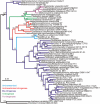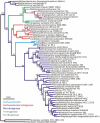An alternative path for the evolution of biological nitrogen fixation
- PMID: 22065963
- PMCID: PMC3207485
- DOI: 10.3389/fmicb.2011.00205
An alternative path for the evolution of biological nitrogen fixation
Abstract
Nitrogenase catalyzed nitrogen fixation is the process by which life converts dinitrogen gas into fixed nitrogen in the form of bioavailable ammonia. The most common form of nitrogenase today requires a complex metal cluster containing molybdenum (Mo), although alternative forms exist which contain vanadium (V) or only iron (Fe). It has been suggested that Mo-independent forms of nitrogenase (V and Fe) were responsible for N(2) fixation on early Earth because oceans were Mo-depleted and Fe-rich. Phylogenetic- and structure-based examinations of multiple nitrogenase proteins suggest that such an evolutionary path is unlikely. Rather, our results indicate an evolutionary path whereby Mo-dependent nitrogenase emerged within the methanogenic archaea and then gave rise to the alternative forms suggesting that they arose later, perhaps in response to local Mo limitation. Structural inferences of nitrogenase proteins and related paralogs suggest that the ancestor of all nitrogenases had an open cavity capable of binding metal clusters which conferred reactivity. The evolution of the nitrogenase ancestor and its associated bound metal cluster was controlled by the availability of fixed nitrogen in combination with local environmental factors that influenced metal availability until a point in Earth's geologic history where the most desirable metal, Mo, became sufficiently bioavailable to bring about and refine the solution (Mo-nitrogenase) we see perpetuated in extant biology.
Keywords: evolution; great oxidation event; iron; metalloenzyme; nitrogenase; oxygen molybdenum; sulfide; vanadium.
Figures








Similar articles
-
Exploring the alternatives of biological nitrogen fixation.Metallomics. 2018 Apr 25;10(4):523-538. doi: 10.1039/c8mt00038g. Metallomics. 2018. PMID: 29629463 Review.
-
Expression of V-nitrogenase and Fe-nitrogenase in Methanosarcina acetivorans is controlled by molybdenum, fixed nitrogen, and the expression of Mo-nitrogenase.Appl Environ Microbiol. 2023 Sep 28;89(9):e0103323. doi: 10.1128/aem.01033-23. Epub 2023 Sep 11. Appl Environ Microbiol. 2023. PMID: 37695043 Free PMC article.
-
Proteome Profiling of the Rhodobacter capsulatus Molybdenum Response Reveals a Role of IscN in Nitrogen Fixation by Fe-Nitrogenase.J Bacteriol. 2015 Dec 7;198(4):633-43. doi: 10.1128/JB.00750-15. J Bacteriol. 2015. PMID: 26644433 Free PMC article.
-
Geobiological feedbacks, oxygen, and the evolution of nitrogenase.Free Radic Biol Med. 2019 Aug 20;140:250-259. doi: 10.1016/j.freeradbiomed.2019.01.050. Epub 2019 Feb 5. Free Radic Biol Med. 2019. PMID: 30735835 Review.
-
Reconstructing the evolutionary history of nitrogenases: Evidence for ancestral molybdenum-cofactor utilization.Geobiology. 2020 May;18(3):394-411. doi: 10.1111/gbi.12381. Epub 2020 Feb 17. Geobiology. 2020. PMID: 32065506 Free PMC article.
Cited by
-
Molecular Mechanism and Agricultural Application of the NifA-NifL System for Nitrogen Fixation.Int J Mol Sci. 2023 Jan 4;24(2):907. doi: 10.3390/ijms24020907. Int J Mol Sci. 2023. PMID: 36674420 Free PMC article. Review.
-
The geobiological nitrogen cycle: From microbes to the mantle.Geobiology. 2017 May;15(3):343-352. doi: 10.1111/gbi.12228. Epub 2017 Feb 3. Geobiology. 2017. PMID: 28158920 Free PMC article. Review.
-
Origin and Evolution of Flavin-Based Electron Bifurcating Enzymes.Front Microbiol. 2018 Aug 3;9:1762. doi: 10.3389/fmicb.2018.01762. eCollection 2018. Front Microbiol. 2018. PMID: 30123204 Free PMC article.
-
Second and Outer Coordination Sphere Effects in Nitrogenase, Hydrogenase, Formate Dehydrogenase, and CO Dehydrogenase.Chem Rev. 2022 Jul 27;122(14):11900-11973. doi: 10.1021/acs.chemrev.1c00914. Epub 2022 Jul 18. Chem Rev. 2022. PMID: 35849738 Free PMC article. Review.
-
The Mononuclear Metal-Binding Site of Mo-Nitrogenase Is Not Required for Activity.JACS Au. 2023 Nov 6;3(11):2993-2999. doi: 10.1021/jacsau.3c00567. eCollection 2023 Nov 27. JACS Au. 2023. PMID: 38034976 Free PMC article.
References
LinkOut - more resources
Full Text Sources
Molecular Biology Databases

